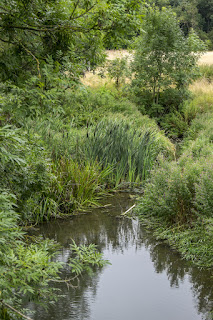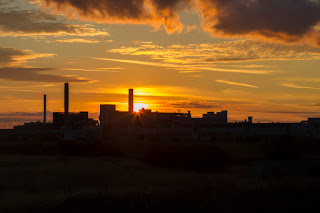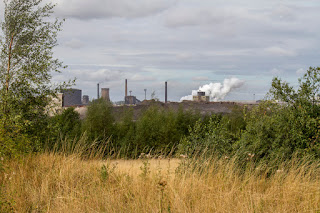What I hope to gain from the Hangout is:-
- Does the work hang together contextually/conceptually
- Does it work without captions
- Could I link the two or should I present them as two separate projects, thinking that the canalized river, railway line and Brayford Pool were once very industrial and the railway line has to a large extent reverted to 'nature'
- Colour or black and white for the industrial images or a mixture
- The two images where I have overlaid old black and white shots over the modern colour ones are meant to evoke feelings of memory and the passing of time, but do they work
- For my last module with my current tutor (PWDP) and for Assignment 1 of L3, I presented all of my work digitally. I am considering different methods of presentation now and wondering whether to send in a set of prints or a photobook or two photobooks. Any suggestions would be appreciated
- I am conscious of not bombarding the viewer with too many images, but, at the same time, feel that it is necessary to tell a story, especially in the case of the river project. Do people have views on this?
- I think that these images, even the industrial ones, have a tendency for the picturesque, largely because of the weather I have been out in. Thinking further ahead, maybe to assignment 3, I wondered about trying to rephotograph both projects as sublime images? Perhaps pair them picturesque against sublime? A thought?
Images can be viewed full screen by clicking on an image. They can then be viewed as a slide show.
I continue to be interested in the Water Rail Way and the River Witham, which runs alongside it. This project is a personal journey as it takes me back to my childhood and youth. I was born and brought up in the small Lincolnshire town of Woodhall Spa close to Woodhall Junction on the Lincolnshire Loop railway line which followed the line of the River Witham from Lincoln to Boston and on to the East Coast main line at Peterborough. In my childhood it was possible to catch the train at Woodhall Junction and get off at Kings Cross. As a young boy and teenager I would often travel to Lincoln on the train and until the early 1960s it was steam hauled. The line was affected by the cuts brought about by Dr Beeching, closed in 1971 and dismantled. Dr Beeching was chairman of British Railways and he became a household name in the 1960s for his report, The Reshaping of British Railways, commonly known as The Beeching Report, which resulted in the closure of over 4000 miles of line. The Lincolnshire Loop Line now has a new lease of life as a traffic free cycle and walking route from Lincoln to Boston and forms part of Sustrans Route 1 cycle route and The Viking Way long distance footpath, which runs from the Humber to Oakham in Rutland and follows the path of the upper as wel as the lower Witham. The line ran adjacent to the river, which has long been well known for angling, especially match fishing and special angling trains ran from Sheffield until 1969. At the weekends several trains would be waiting in the sidings at Woodhall Junction to take them all home. In my younger years I was a keen angler and a regular on the Witham. One of my fondest childhood memories is of being taken to the signal box at nearby Stixwould Station to have my haircut and, on one occasion, my finger 'put back into joint' by the signal man, who doubled as barber and bone setter. Several of the old stations have recently been converted to quirky homes. I have cycled much of this route and photographed the journey, along with the old stations and the black and white photographs of days gone by on the many information boards along the line. The cycle route has been named the Water Rail Way to encompass railway, river and wildlife.
The upper River Witham rises in the limestone hills of the Lincoln Edge and is a fast flowing chalk stream, whereas the lower river has been canalized for transport and is slower and more turgid. Interestingly, the fact that the river cuts through the limestone at the Lincoln Gap, enabled Lincoln to develop as a communications hub with river, rail and road transport. In the centre of Lincoln it opens up to become The Brayford Pool, once a busy industrial waterfront with excellent views to Lincoln's stunning cathedral. All of this is tied in with my childhood memories of the area. It rises just west of the A1 between Stamford and Grantham, flows north to Lincoln and then south east to Boston where it flows out into the sea into The Wash. Coming from Lincolnshire, I am also fascinated by The Brook by Lincolnshire Poet Laureate Alfred, Lord Tennyson, which as well as describing the course of a river is also an allegory of Life. In the last stanza the brook curves and finally joins the brimming river. Tennyson concludes with the words For men may come and men may go but I go on for ever. which shows the transient life of human beings in contrast to the eternal life of the river. Even though the brook ends, it becomes part of the river, which flows out to sea and so it continues to flow endlessly.
Although I have photographed much of the course of the river, I still need to take pictures as it flows through Boston and out to sea.
I see these photographs presented in a linear fashion in order to portray the idea of a personal journey and the journey of a river.
Although I gave the industry aspect in Assignment 1 the two titles Flowers in an Industrial Setting and Industry within the Landscape, I am planning to combine these two. At this time of year the flowering season is past us and most images of flowers within an industrial setting will need to wait now until next spring. Having said that I have changed my focus. I am still interested in industrial landscapes, but am becoming fascinated by how industry and nature coexist, in some cases industrial companies provide space for nature within their environs; for example Novartis on the Humber Bank has developed an area adjacent to its plant specifically as a high tide roost for shore birds to rest until they can return to the mudflats to feed. As much as we may hark back to and wish for a bygone rural idyll, wilderness is a thing of the past, if it ever existed. We only have to look at Scotland, Wales and the Lake District with the preponderance of nuclear power stations and latterly wind farms within their boundaries. And people in these places need to have employment, which is often provided by industry. John Davies' image of Trawsfynydd Power Station in Snowdonia is a prime example. We all desire the commodities of modern life (food, fuel for our cars, electricity, gas) however 'green' we are. I am interested in portraying this industry within our rural landscape and also in the coexistence of nature alongside it and of the rewilding of post industrial sites and how nature reclaims its own. The work being done in Pripyat and Chernobyl by photographers such as Christofer Bennett testifies to this. Having said that, I am interested in the view that nature and landscapes are concepts of western culture and that some animist cultures do not have a word for nature or wilderness as they feel that they are part of it.
These pictures do not need to viewed linearly and would, perhaps be better seen in groups.
These pictures do not need to viewed linearly and would, perhaps be better seen in groups.




















































You may be interested in having a look at this work; http://www.muellerpohle.net/projects.html
ReplyDeleteMike, something I didn't get round to say was that in terms of aesthetics, do you think that if you were to reprocess certain images it could result in a less "picturesque" theme?
ReplyDeleteIn my notes I wrote: I think the images will always benefit from either individual caption or or unified text (introduction), in the case of caption a thought around a particular moment or anecdote that took place at the actual place photographed might be a good thing to play around conceptually.
Finally, if you were to take the actual journey of the river, instead of following the river, as in the case of Muller-Pohle, will it be fesable for you to do. I think that the perspective might help. I'm also thinking of giving this a go.
Thank you for sharing, it's really helpful to comment on our peers' work as it helps widening the view of our own.
Thanks for your comments Yiann, they are really useful. I have had a quick look at Andreas Muellerpohle's website and it looks really interesting.
DeleteMany thanks for your support.
Oh and also if somehow you get to watch the BBC Four Goes Slow film about the canal trip.
ReplyDelete